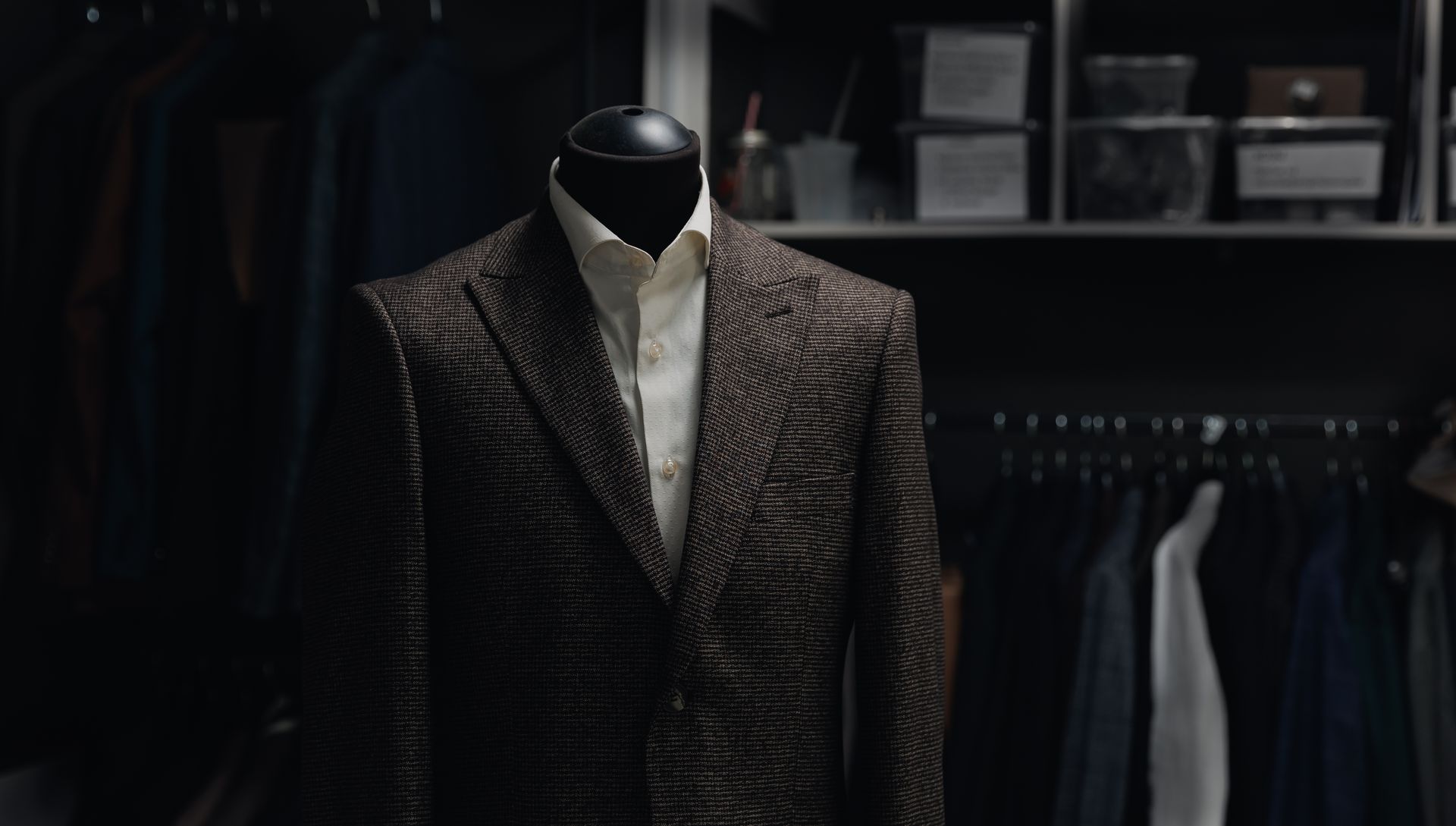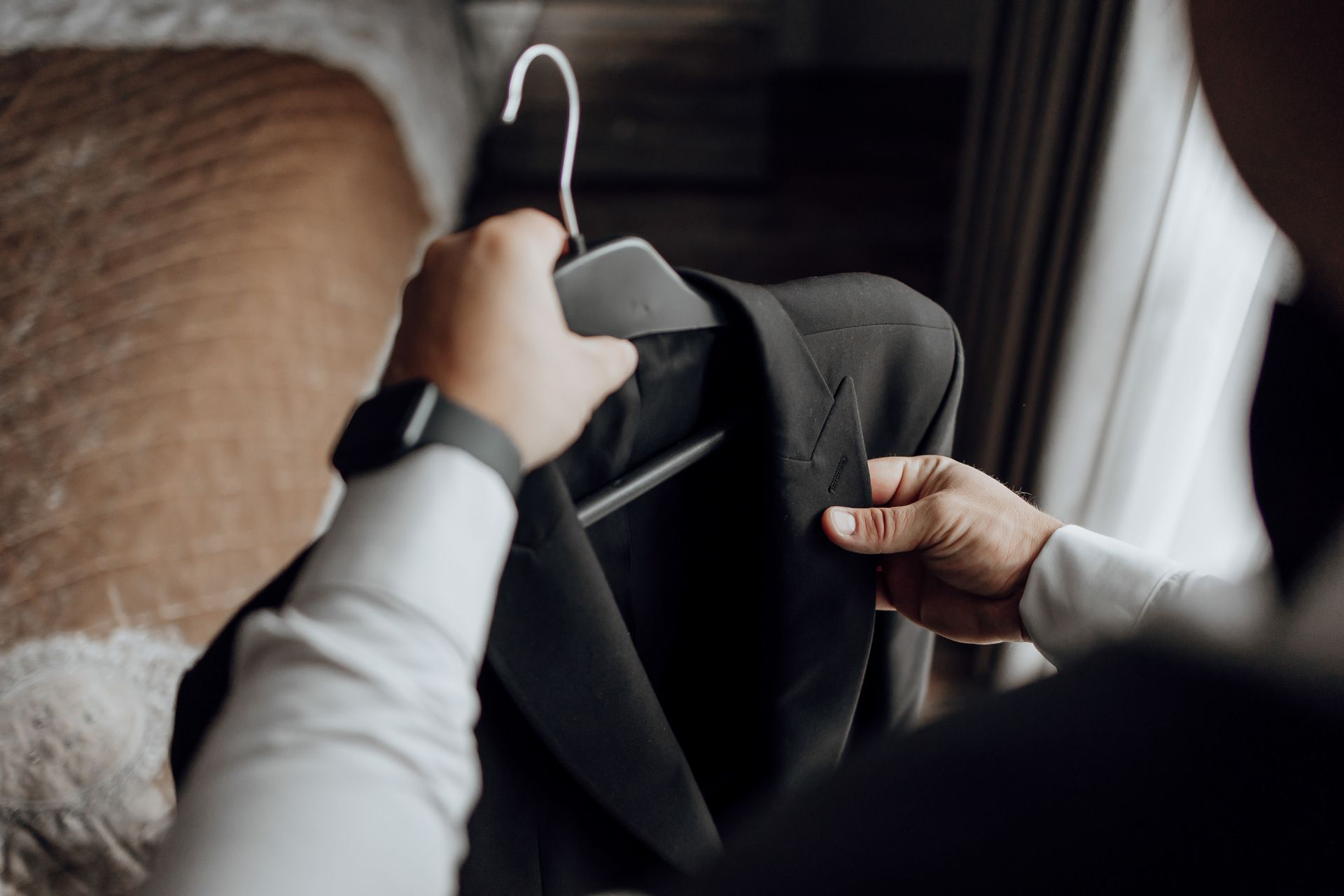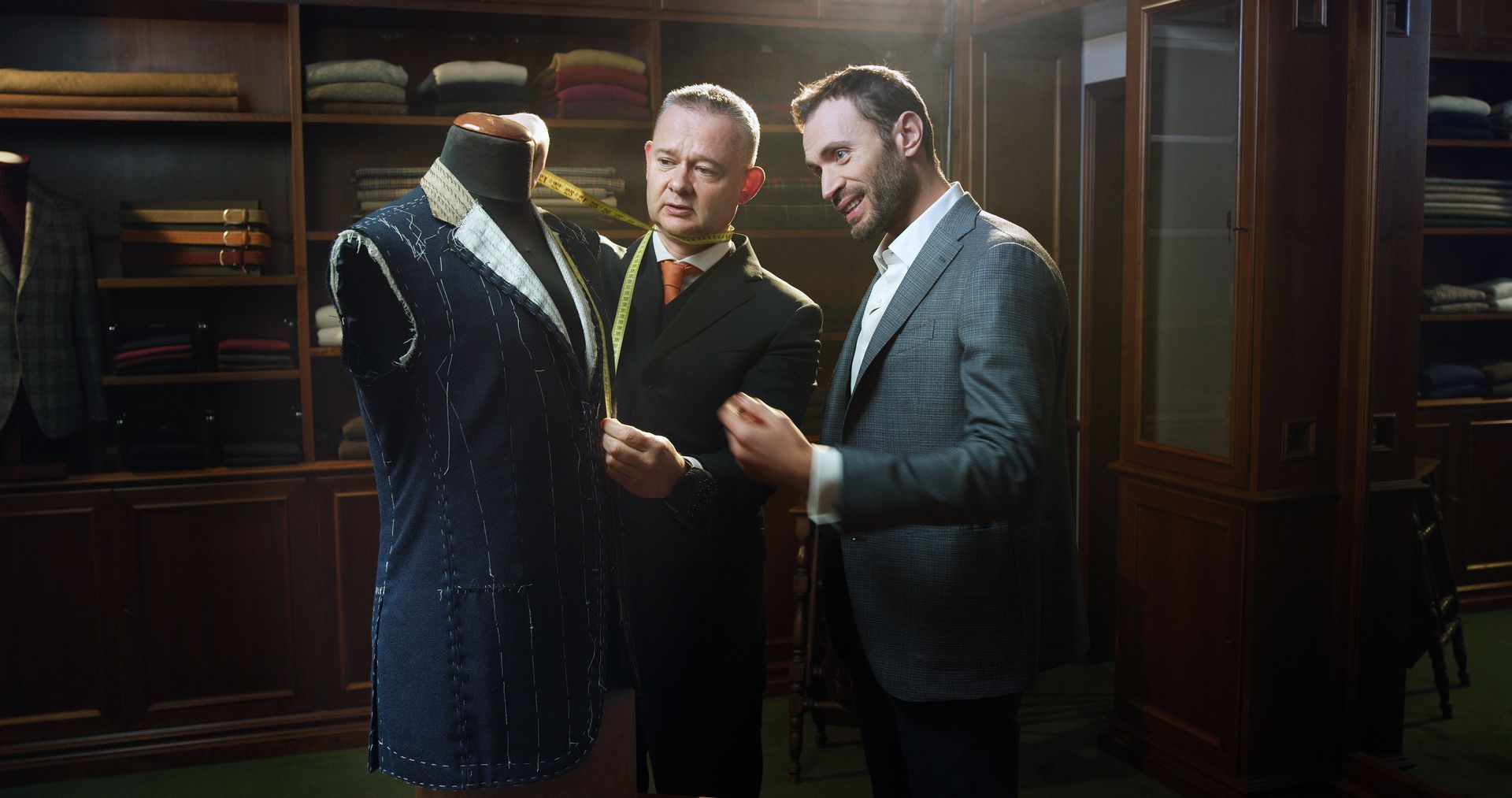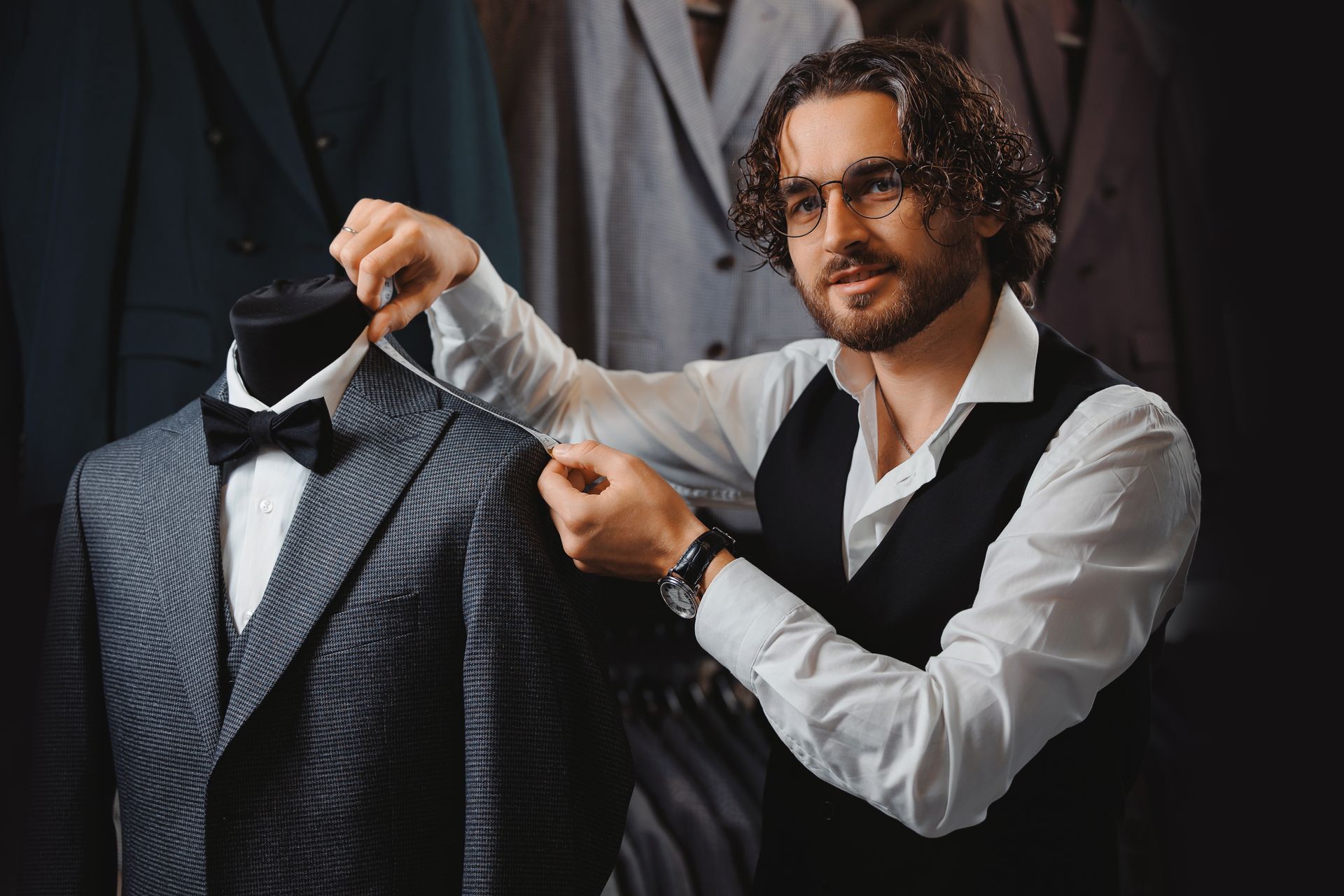Custom Suit & Shirts Tips 101
Buying Your First Suit
So you're thinking about buying your first suit. Here are a few helpful tips to ensure your suit lasts the test of time. I really like neutral colors for your first suit: navy blue, midnight blue, and the most classic medium gray. This gray is not as dark as charcoal gray, which sometimes appears black. Speaking of black suits, this should be your last choice. Opt for blue or gray for your first option. Your combinations are endless. Wearing it with the classic white, you can never go wrong. For a more business-like look, try light blue, or for just a pop of fun, a soft shade of lavender is great for hanging out at the pub or having dinner with friends. Most guys would probably start off with a solid fabric. My first option would be something in one of the shades in a tight glen plaid pattern. It looks solid from across the room, but once you look closer, it starts to perform a subtle dance, setting you apart from the average bloke. But without a doubt, the fabric is just the start; the fit is, if not more important. You can easily take a less expensive suit, have it tailored well, and outshine your competition.
What You Need to Know About Custom Suits 101
Canvas Construction:
- Materials: Canvas construction involves a layer of canvas, usually made from horsehair or a blend of natural fibers, that is sewn into the interior of the suit jacket.
- Characteristics: This construction method allows the suit to mold to the wearer's body over time, providing a more natural fit and drape. It also enhances breathability and durability.
- Advantages: Suits with canvas construction tend to be more expensive due to the additional labor and higher-quality materials. However, they are often considered more comfortable and have a longer lifespan.
Half Canvas vs. Full Canvas:
- Half Canvas: In a half-canvas construction, the canvas layer only extends through the chest and lapel area of the jacket. Below that, the jacket is typically fused. This allows for a balance between cost and some of the benefits of canvas construction.
- Full Canvas: In a full canvas construction, the canvas layer extends throughout the entire front of the jacket, providing maximum support and shaping. This is often considered the highest quality of suit construction but it’s more expensive.
What You Need to Know About Custom Suits 101
- Purpose and Occasion: Understand the purpose of the suit (business, casual, formal events) and the occasions you plan to wear it for. This will guide decisions on fabric, style, and detailing.
- Fabric Selection: Choose the right fabric based on the season and purpose. Wool is versatile and suitable for various climates, while linen and cotton are ideal for warmer weather. Super numbers indicate the fineness of the wool, with higher numbers indicating finer fibers.
- Suit Style: Decide on the suit style that complements your body type and personal taste. Options include single-breasted, double-breasted, two-button, three-button, etc.
- Measurements: Accurate measurements are crucial for a well-fitted custom suit. Pay attention to chest, shoulders, waist, hips, sleeve length, and inseam. Tailors may take additional measurements for a more precise fit.
- Customization Options: Discuss customization options such as lapel style, pocket style, vents (single, double, or none), button stance, and trouser details. These details contribute to the overall aesthetics of the suit.
- Lining and Inner Construction: Decide on the lining material and inner construction of the suit. Options include fully lined, half-lined, or unlined suits. The inner canvas construction influences the suit's drape and shape.
- Color and Pattern: Choose a color that complements your skin tone and can be versatile for different occasions. Solid colors and classic patterns like stripes or checks are often safe choices.
- Budget Considerations: Custom suits can vary widely in price. Establish a budget beforehand and communicate it to the tailor. Understand that quality materials and craftsmanship may come at a higher cost.
- Fitting Sessions: Expect multiple fitting sessions during the custom suit-making process. This ensures that any adjustments needed for the perfect fit can be made.
- Lead Time: Custom suits take time to craft, so plan ahead. Depending on the tailor and complexity of the design, it may take 4-7 weeks from measurement to completion.
- Communication with the Tailor: Clear communication with the tailor is essential. Be vocal about your preferences, any specific design elements you desire, and how you want the suit to feel and look.
- Care and Maintenance: Understand the proper care for your custom suit. Follow care instructions for cleaning and storing to maintain its quality and longevity.Investing in a custom suit is a significant decision, and attention to these details will help ensure you get a suit that not only fits well but also reflects your style and personality.
Contact Nelson's Bespoke for Assistance
If you encounter any issues with your shirt, reach out directly to
Nelson's Bespoke. Many high-quality and bespoke clothing brands, including Nelson's Bespoke, offer repair services or may provide guidance on how to proceed. If direct assistance is not possible, consult a professional tailor or a reputable alteration shop. Choose a tailor experienced in working with high-quality fabrics and intricate stitching to ensure precise and careful repairs
How to Take Care of Your Custom Suit 101
- Rotate Your Attire: Give your suits and sport coats a breather between wears. Regardless of weather or perceived sweat, refrain from wearing them two days in a row. This downtime allows the garment to release moisture and maintain its shape.
- Invest in Proper Hangers: As you upgrade your wardrobe, ensure you have suitable hangers. Opt for wider hangers that fully support the shoulders of your suits, avoiding thin metal hangers typically provided by dry cleaners. Proper hangers prevent damage and help retain the garment's structure.
- Brush for Care: A soft-bristled suit brush is a wise investment for maintaining your attire. Gently brushing your suits removes dust, refreshes the fabric, and prevents snags. Let your suit breathe by hanging it outside during the day, particularly in winter, to eliminate odors and moisture. Be cautious of hanging it outside at night, as moths may be drawn to the fabric.
- Storage Solutions: If your suits won't be worn for an extended period, such as six months or more, store them in suit bags. This protects them from dust, moths, and outdoor elements, preserving their quality for longer.
- Ironing Technique: When ironing your suit, never directly apply a hot iron to the fabric. Instead, place a towel over the suit and iron gently with steam to release wrinkles and set creases. By adhering to the first rule of not wearing your suits consecutively and minimizing dry cleaning, you'll extend their lifespan considerably.
- Handle Spills with Care: Accidents happen, but they need not be permanent blemishes on your custom suit. Whether it's a splash of coffee or a dribble of sauce, swift action is key. Blot the affected area immediately with a clean cloth or paper towel to absorb as much of the spill as possible without rubbing, which could embed the stain further into the fabric.
By implementing these tips into your suit care routine, you'll ensure your attire remains impeccable and lasts for years to come, maintaining the sophistication and quality expected of a true professional.
How to take care of your custom shirt 101
Taking care of your custom bespoke shirt is essential for preserving its quality and longevity. With these simple tips, you can ensure that your shirts remain crisp, clean, and stylish for years to come.
- Separate Colors: Always separate your custom shirts by color before washing to prevent color bleeding.
- Avoid Starch and Bleach: While starch can provide a crisp look, excessive use may damage shirts. Bleach weakens fabric and causes discoloration, especially on colored shirts. Use them sparingly or consider alternatives for longevity.
- Wash in Cold Water and Air-Dry: To prevent shrinkage and remove excess dirt, wash the shirt in cold water. Gently pull the shirt out, slightly damp, and let it air-dry.
- Ironing: Learn to iron your shirt, as it contributes to its longevity. Mist the shirt with steam before ironing, relaxing wrinkles. The heat from the iron sets and holds the press.
- Stain Removal: If a stain occurs, don't wipe it. Gently blot with a clean, dry towel. Avoid home remedies like club soda. Take the shirt to a trusted cleaner, informing them of the stain type and any used products.
- Store Properly: Hang your shirts on wooden or padded hangers to maintain their shape and avoid wrinkles.
- Minimize Dry Cleaning: Reduce the frequency of dry cleaning your custom shirt to prolong its lifespan and preserve the fabric's.
- Regular Maintenance Checks: Periodically inspect your custom shirts for loose threads, missing buttons, or other signs of wear. Addressing these issues promptly prevents further damage and maintains the shirt's appearance and functionality
- Regular Maintenance Checks: Periodically inspect your custom shirts for loose threads, missing buttons, or other signs of wear. Addressing these issues promptly prevents further damage and maintains the shirt's appearance and functionality.
- Contact Nelson's Bespoke:
If you encounter any issues, contact Nelson's Bespoke
directly. High-quality brands often offer repair services or guidance. If direct assistance is not possible, consult a skilled tailor or reputable alteration shop for precise and careful repairs.
Buying Your First Suit
So you're thinking about buying your first suit. Here are a few helpful tips to ensure your suit lasts the test of time. I really like neutral colors for your first suit: navy blue, midnight blue, and the most classic medium gray. This gray is not as dark as
charcoal gray, which sometimes appears black. Speaking of black suits, this should be your last choice. Opt for blue or gray for your first option. Your combinations are endless. Wearing it with the classic white, you can never go wrong. For a more business-like look, try light blue, or for just a pop of fun, a soft shade of lavender is great for hanging out at the pub or having dinner with friends. Most guys would probably start off with a solid fabric. My first option would be something in one of the shades in a tight glen plaid pattern. It looks solid from across the room, but once you look closer, it starts to perform a subtle dance, setting you apart from the average bloke. But without a doubt, the fabric is just the start; the fit is, if not more important. You can easily take a less expensive suit, have it tailored well, and outshine your competition.
What to Consider When Going to a Custom Tailo
The Right Fit
If you’re planning to buy a suit, you should consider going custom. A custom suit is different from a ready-made suit because it’s made exactly to the measurements of a person’s body. Ready-made suits are popular because they are already cut and manufactured to fit a specific body type. If you want a different fit or style, you’ll have to rely on a custom tailor. You can also ask for a discount if you bring in your own fabric. Here are some reasons you should consider going custom:
Specificity
A custom suit is made to fit a specific person. If you’re looking for a one-of-a-kind suit, this is the best option for you. You won’t have to worry about the suit fitting badly because it was made based on your measurements. When you go custom, the suit will fit you just right.
Flexibility
You should go custom if you have a lot of options. A ready-made suit is usually made with a single fabric that suits a specific body type. You can’t go all out with a custom suit because it requires a lot of fabrics. However, you can still choose a fabric that you like.
Save Costs
If you want to save money, buying custom suits is the way to go. With a ready-made suit, you need to purchase the fabric and pay for the labor costs. If you go custom, you can just provide the fabric and the tailor will do the rest.
If you’re looking for a custom suit, consider hiring a custom tailor such as Nelson's Bespoke. I provide a custom suit service in Dallas, TX. Give me a call at (214) 293-6808 today so I can take your proper measurements right away! I’ll have your suit done for you in no time!
Services List
Custom Suits
Shirts
Sports Coats
Jackets
Dress Pants
Business Attire
Tuxedos
Wardrobe Planning
Wardrobe Consulting
Custom Tuxedo
Custom Overcoat
BUSINESS HOURS
- Mon - Sat
- -
- Sunday
- Closed




